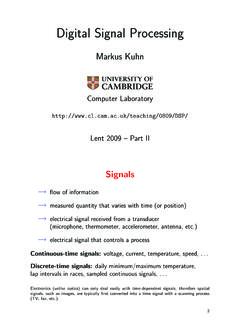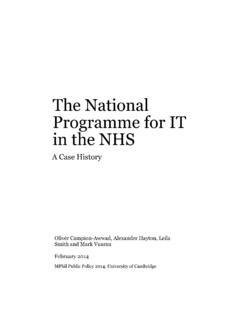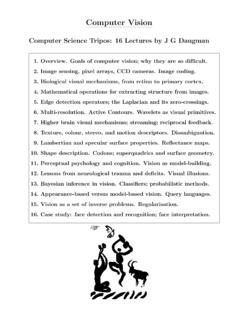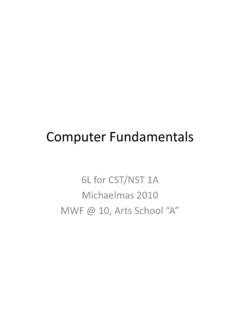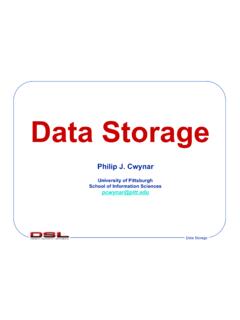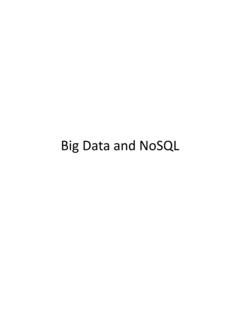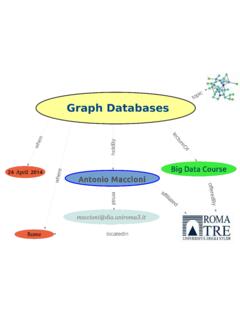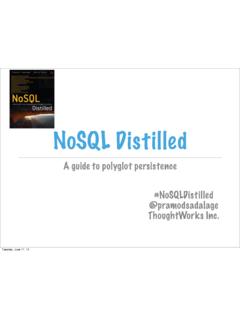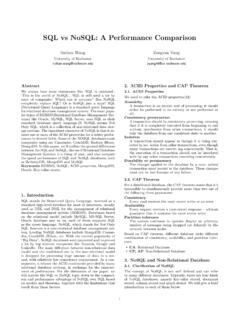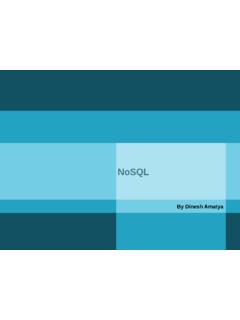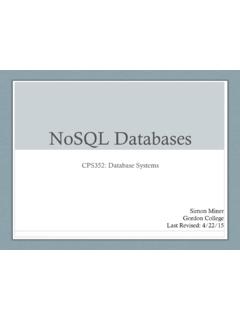Transcription of Databases : Lecture 11 : Beyond ACID/Relational databases ...
1 Databases : Lecture 11 : Beyond ACID/Relational Databases timothy G. griffin Lent Term 2014 Rise of Web and cluster-based computing nosql Movement Relationships vs. Aggregates Key-value store XML or JSON as a data exchange language Not all applications require acid CAP = Consistency, Availability, and Partition tolerance The CAP theorem (pick any two?) Eventual consistency Apologies to Martin Fowler ( nosql distilled ) Application-specific Databases have always been with us .. Daytona (AT&T): Daytona is a data management system, not a database . Built on top of the unix file system, this toolkit is for building application-specific and highly scalable data stores.
2 Is used at AT&T for analysis of 100s of terabytes of call records. ~daytona/ DataBlitz (Bell Labs, 1995) : Main-memory database system designed for embedded systems such as telecommunication switches. Optimized for simple key-driven queries. But these systems are proprietary. Open source is a hallmark of nosql Two that I am familiar with: What s new? Internet scale, cluster computing, open source .. Something big is happening in the land of Databases The Internet + cluster computing + open source systems many more points in the database design space are being explored and deployed Broader context helps clarify the strengths and weaknesses of the standard relational / acid approach.
3 Eric Brewer s PODC Keynote (July 2000) acid vs. BASE (Basically Available, Soft-state, Eventually consistent) Strong consistency Isolation Focus on commit Nested transactions Availability? Conservative (pessimistic) Difficult evolution ( schema) Weak consistency Availability first Best effort Approximate answers OK Aggressive (optimistic) Simpler! Faster Easier evolution A wide spectrum with many design points Real internet systems are a careful mixture of acid and BASE subsystems acid BASE The emerging world of Databases relational Postgres MySQL Graph Databases Neo4j VertexDB Key-Value stores Riak Redis BerkeleyDB Column-oriented Databases BigTable, Cassandra Hbase (build on Hadoop) Document-oriented MongoDB CouchDB Often overlooked in the business-oriented hoopla: This is making BigAnalytics affordable for many scientific efforts (bioinformatics, astronomy, physics, economics.)
4 This classification is not Complete and is a bit fuzzy-wuzzy. For example, drawing a clear distinction between Key-value stores and Document-oriented Databases is not always easy. And this is Rapidly evolving with a lot of cross-fertilization. The emerging world of Databases relational Postgres MySQL Graph Databases Neo4j VertexDB Key-Value stores Riak Redis BerkeleyDB Column-oriented Databases BigTable, Cassandra Hbase (build on Hadoop) Document-oriented MongoDB CouchDB Aggregate-oriented, Eventual consistency Attribute-oriented, acid Aggregates as a natural unit of update Martin Fowler : Welcome to the world of polyglot persistence More and more we will see data-oriented systems do and will combine traditional relational DBMS technology with nosql technology.
5 Must understand what problems each technology solves Use right tool for the job This Lecture : I will put emphasis on applications of the form Traditional RDBMs (normalized/ acid ) Extract Aggregate-oriented data stores. nosql technology Key-Value Stores Mapping Key to blob-of-byte that application must parse Example : Riak (modeled on Dynamo, eventual consistency), Cassandra Typically no query-language for values Mapping Key to semi-structured value Example: Redis Huge advantage: can design data representation so that all data needed for a given update is present on a single machine. Data can easily be partitioned (say by key ranges) over many machines.
6 Map-reduce initiated from set of keys .. Disadvantage: Data retrieved by key only. And it is hard to enforce relationships between different values. If this is important for your applications, then perhaps Look elsewhere .. Tables require joins S(A, B, C) R(C, D, E) T(E, F) (FK = Foreign Key) FK FK A B C D E F A1 B1 C1 D1 E1 F1 A1 B1 C1 D2 E2 F2 A1 B1 C1 D3 E3 F3 A2 B2 C2 D4 E4 F4 A2 B2 C2 D5 E5 F5 .. How could tables be partitioned over multiple servers? Enforcing referential integrity is VERY difficult in a distributed database The Key-value approach S(A, B, C) R(C, D, E) T(E, F) (FK = Foreign Key) FK FK A B C D E F A1 B1 C1 D1 E1 F1 A1 B1 C1 D2 E2 F2 A1 B1 C1 D3 E3 F3 A2 B2 C2 D4 E4 F4 A2 B2 C2 D5 E5 F5.
7 {A : A1, B : B1, stuff : [ {D : D1, F: F1}, {D : D2, F: F2}, {D : D3, F: F3} ] } The collection of JSON objects (keyed on A) is horizontally partitioned (sharded) across many servers. When accessed, all of the application s data is in one object. Use this instead Example from Lecture 1 13 Document-oriented systems can be to manage the RDBMS Publishing Problem DB 2 DB 2 DB 1 DB 3 DB 5 DB 4 Exports Excel Exports HTML Exports printed documents Exports Word Documents Exports .txt files in ad hoc format Exports .txt files in ad hoc format Need to share data without exposing internal details of your database . Lack of standard exchange formats requires the implementation of many ad hoc translators 14 XML (or JSON) as a data exchange format DB 2 DB 2 DB 1 DB 3 DB 5 DB 4 Exports XML Exports XML Exports XML Exports XML Exports XML Exports XML XML/JSON conforming to agreed upon semantics Using document- oriented nosql software for data exchange is an attractive option.
8 15 Examples of domain specific XML DTDs (similar developments with JSON) There are now lots of DTDs that have been agreed by groups, including WML: Wireless markup language (WAP) OFX: Open financial exchange CML: Chemical markup language AML: Astronomical markup language MathML: Mathematics markup language SMIL: Synchronised Multimedia Integration Language ThML: Theological markup language Fallacies of Distributed Computing (Peter Deutsch) Essentially everyone, when they first build a distributed application, makes the following eight assumptions. All prove to be false in the long run and all cause big trouble and painful learning experiences. 1. The network is reliable 2.
9 Latency is zero 3. Bandwidth is infinite 4. The network is secure 5. Topology doesn't change 6. There is one administrator 7. Transport cost is zero 8. The network is homogeneous Brewer s CAP conjecture (2000) Consistency Availability Partition tolerance Conjecture : You can have at most two. Nancy Lynch and Seth Gilbert, Brewer's conjecture and the feasibility of consistent, available, partition-tolerant web services , ACM SIGACT News, Volume 33 Issue 2 (2002), pg. 51-59. A formal proof: But what do the CAP terms really mean? There seems to be no consensus .. Consistency The system can guarantee that once you store a state in the system, it will report the same state in every subsequent operation until the state is explicitly changed by something outside the system.
10 Is equivalent to having a single up-to-date copy of the data Availability All clients can find some replica of the data, even in the presence of failures A guarantee that every request receives a response about whether it was successful or failed Partition tolerance The system properties hold even when the system is partitioned The system continues to operate despite arbitrary message loss or failure of part of the system Random samples of various definitions found in the literature .. Pick any two? A better formulation. Suppose you have a highly distributed system then you must engineer trade-offs between Consistency Availability
